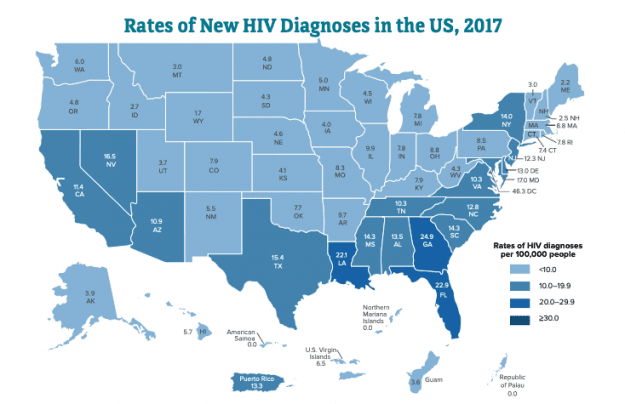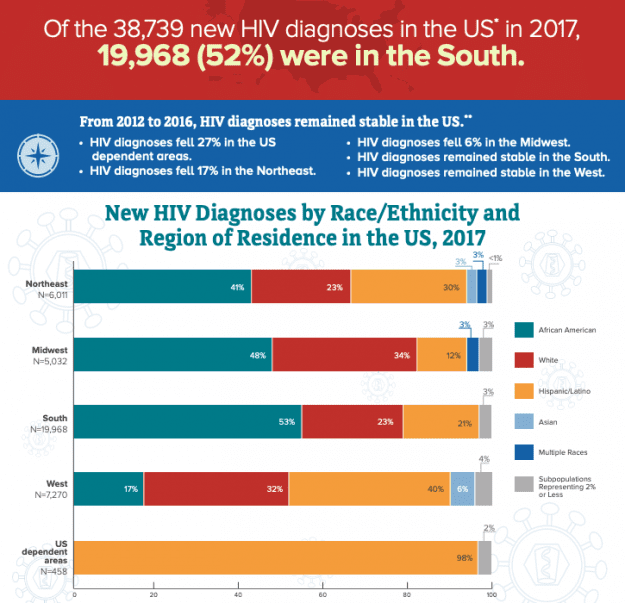The numbers are finally in for 2017 regarding how HIV diagnoses are distributed across the US and regions. Around 1.1 million people are living with HIV in the US. Southern states accounted for more than half of the 38,739 new HIV diagnoses in 2017.
Overall, in the 50 states and the District of Columbia only, the majority of people who receive an HIV diagnosis live in urban areas. But in the South, 23% of new HIV diagnoses are in suburban and rural areas, and in the Midwest 21% are suburban or rural—higher proportions than in the Northeast and West. The South’s larger and more geographically dispersed population of people living with HIV creates unique challenges for prevention and treatment.
Understanding the places and populations that are most affected by HIV allows the federal government to allocate its resources to the geographic areas where they are needed most, while still supporting a basic level of HIV education and prevention for everyone across the country.
Once again, these are statistics on new diagnoses, not the total population living with HIV.
HIV Diagnoses
In 2017:
- The South made up 52% (19,968) of the new HIV diagnoses in the US, followed by the West (7,270; 19%), the Northeast (6,011; 16%), and the Midwest (5,032; 13%). US dependent areas made up 458 (1%) of new HIV diagnoses.
- The rates (per 100,000 people) of HIV diagnoses were 16.1 in the South, 12.3 in the US dependent areas, 10.6 in the Northeast, 9.4 in the West, and 7.4 in the Midwest.
From 2012 to 2016:
HIV diagnoses remained stable in the US, although some decreases were seen in regions with fewer diagnoses.
- US Dependent Areas: Decreased 27%
- Northeast: Decreased 17%
- Midwest: Decreased 6%
- South: Remained stable
- West: Remained stable
Forty-four percent of people diagnosed with HIV live in the South, even though the region only contains about a third of the U.S. population.
In looking at the where the largest concentration in regard to cities, here are the rates of HIV diagnoses pre 100,000.
10. Baltimore, Maryland – 24.3
Aside from Baltimore, all of the cities in the top 10 are in the South.
9. Jacksonville, Florida – 25.1
8. Columbia, South Carolina – 25.6
7. Atlanta, Georgia – 25.9
6. Memphis, Tennessee – 27.6
5. Orlando, Florida – 28.8
4. Jackson, Mississippi – 32.2
3. New Orleans, Louisiana – 36.9
2. Miami, Florida – 42.8
1. Baton Rouge, Louisiana – 44.7
What are the reasons these cities are on the top 10 list? Just like with everything, there is no one cause for or one cure to a problem. Here are a list of problems highlighted by blackdoctor.org for why these cities may have the highest HIV diagnoses rates in the nation.
- lack of education
- tourism
- poverty
- rural geography
- lack of affordable healthcare
- social stigma – being a part of the ‘Bible Belt’
- a diagnosed person might not seek treatment due to fear of rejection from the religious community
- people who have the disease are not aware of it, so they may continue to spread the infection
- Most people in these regions don’t have access to prevention, treatment, and care programs
- due to shared needles because of opiate addiction crisis
h/t: blackdoctor.org, www.cdc.gov,




It’s not surprising that the
It's not surprising that the south is where the increases were. This has been stated before, it's due to the number of retirees that don't believe they have to wear condoms any longer. They don't realize they have to still play safe.